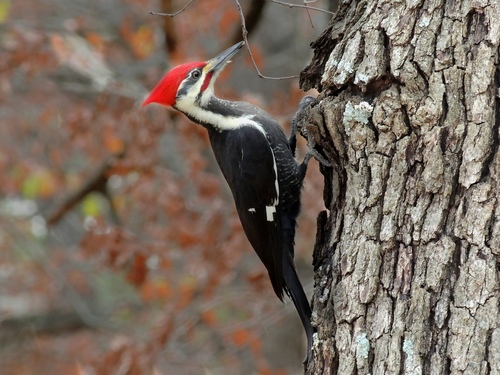
Pileated Woodpecker
The Pileated Woodpecker (Dryocopus pileatus) is a large, striking woodpecker native to North America, renowned for its impressive size, bold black and white plumage, and prominent red crest. It plays a crucial ecological role as a primary excavator, creating cavities that are subsequently used by a wide variety of other forest animals, including birds, mammals, and reptiles. While not typically considered a bird of significant cultural importance, its distinctive appearance and loud calls make it a readily recognizable and iconic symbol of North American woodlands.
40-49 cm
Length
66-75 cm
Wingspan
Least Concern
Conservation Status
Distribution
The Pileated Woodpecker is found across much of North America, extending from the boreal forests of Canada south through the eastern United States and parts of the Pacific Northwest. It is generally non-migratory, although some northern populations may move short distances south in winter.
Lifespan
Up to 12 years in the wild, although average lifespan is likely shorter.
Pileated Woodpecker's Habitat
Habitat Types
Mature forests, Wooded areas with large trees, Deciduous and coniferous forests, Suburban areas with sufficient tree cover
Climate Zones
Temperate, Boreal, Subtropical (in the southeastern US)
Adaptations
Pileated Woodpeckers possess strong, chisel-like bills for excavating wood, reinforced skulls to withstand the impact of pecking, and long, barbed tongues for extracting insects from deep crevices. Their zygodactyl feet (two toes pointing forward, two backward) provide a strong grip on tree trunks.
Variations
Several subspecies are recognized, differing slightly in size and plumage darkness. These variations are generally clinal, meaning they change gradually across geographic regions.
Appearance
Breeding Plumage
Plumage is generally consistent year-round.
Seasonal Feather Changes
No significant seasonal variations.
Sex Based Plumage Differences
Males have a red 'mustache' stripe extending from the bill, while females have a black stripe in the same area. Both sexes possess the prominent red crest.
Notable Features
Large size, Prominent red crest, Black and white plumage, Strong, chisel-like bill
Diet and Feeding
Primary Foods
Carpenter ants, Wood-boring beetle larvae, Other insects, Fruits, Nuts, Berries
Foraging Behavior
Pileated Woodpeckers primarily forage by excavating large, rectangular holes in trees to access insects. They use their powerful bills to peel away bark and chip away wood, listening for the sounds of insects within. They may also glean insects from the surface of trees or the ground.
Specializations
Their long, barbed tongue, coated in sticky saliva, is perfectly adapted for extracting insects from deep within tree trunks and branches.
Seasonal Diet Variations
While carpenter ants and wood-boring beetle larvae form the core of their diet, they will consume more fruits, nuts, and berries during the fall and winter when insects are less abundant.
Behavior
Social Structure
Pileated Woodpeckers are generally solitary or found in pairs, except during the breeding season. They are territorial and defend their territories year-round.
Communication
Loud, resonant drumming on trees, A loud, ringing 'wuk-wuk-wuk' call, Other vocalizations, including softer calls and rattles
Migration
Generally non-migratory, although some northern populations may move short distances south in winter in response to severe weather or food shortages.
Territorial or Group Behaviors
Pileated Woodpeckers are highly territorial, defending their feeding and nesting areas from other woodpeckers and potential competitors. Territories can be quite large, encompassing several acres of mature forest.
Conservation
Threats
Habitat loss (due to deforestation and logging), Loss of snags (dead trees) needed for nesting, Pesticide use (affecting insect prey)
Protection Programs
Forest management practices that retain large trees and snags, Protection of mature forests, Public education about the importance of woodpeckers
Local National Laws
Protected under the Migratory Bird Treaty Act in the United States.
Population Trend
Stable
Population Estimates
The global population is estimated to be around 1.9 million individuals.
Interesting Facts
They can excavate holes up to several feet deep.
This remarkable ability allows them to reach insect prey deep within trees.
The rectangular shape of their foraging holes is unique.
This distinguishes their work from that of other woodpecker species.
They are one of the largest woodpecker species in North America.
Only the Ivory-billed Woodpecker, which is likely extinct, and the Imperial Woodpecker are larger.
Their drumming can be heard up to a half-mile away.
The loud, resonant sound serves to advertise territory and attract mates.
Faqs about Pileated Woodpecker
What do I do if a Pileated Woodpecker is damaging my house?
While Pileated Woodpeckers primarily target dead trees, they may occasionally damage wooden siding. Deterrents include covering the area with netting or reflective materials, removing potential food sources (insect infestations), and providing alternative nesting sites (nest boxes). Consult a wildlife professional for advice.
Are Pileated Woodpeckers beneficial to forests?
Yes, they are considered keystone species. Their excavated cavities provide nesting and roosting sites for many other animals, and their foraging activities help control insect populations, contributing to forest health.
How can I attract Pileated Woodpeckers to my yard?
Providing a source of suet, leaving dead trees or snags standing (if safe to do so), and maintaining a wooded area with mature trees can help attract Pileated Woodpeckers.
Do they migrate?
Pileated Woodpeckers are generally non-migratory. However, individuals in the northernmost parts of their range or at higher elevations may shift their location slightly during harsh winters to find more accessible food.
Copyright @ Nature Style Limited. All Rights Reserved.
 English
English